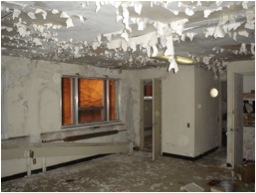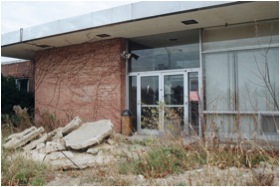Destruction of former psychiatric hospital raises environmental concerns
By Elisabeth Pernicone
Spring 2010
A thriving psychiatric hospital once stood on a 414-acre property in southeast Michigan. The facility housed thousands of long-term patients who took advantage of the site’s many amenities, including a movie theater, basketball court and swimming pool.
Now the desolate property is littered with “Do Not Trespass” signs. Asbestos fills the floors and crumpling walls of the remaining structures. Lead, arsenic, and other contaminants poison the soil.
Northville Regional Psychiatric Hospital closed in 2003 as patient numbers dwindled. Subsequent residential development projects fell through because of the increased traffic that would result, leaving the property vacant. While residential housing is not in the foreseen future, it is not ruled out of the question. Now the city plans to transform the area into a nature preserve with a section allocated for commercial businesses, but the threat to humans and the environment is still unknown.
Demolition of the remaining structures of the hospital may not be done for several years. But many nearby residents have safety concerns.
Stephen Danna lives a block away from the former hospital. As he stands by his mailbox, the main building is in clear sight, no more than 500 feet away.
“We would be affected the most compared to anyone else,” Danna says. “How is it going to be managed? What will the environmental effects be? We are concerned.”
WOUNDS DUG DEEP
Northville isn’t the only hospital to scar its surroundings. More than 450,000 contaminated hospitals and industrial properties exist nationwide, according to the U.S. Environmental Protection Agency. Called “brownfield” properties, these sites have real or perceived environmental contamination, which deters companies from redeveloping.
The agency is currently cleaning up 7,117 sites in the Great Lakes region.
Most of the contaminants at Northville are below levels of concern, according to the EPA. But levels of asbestos, arsenic, and benzopyrene would be potentially dangerous if the site was to become a residential area and may pose risks for frequent visitors if the site is turned into a nature preserve, according to an analysis of reports obtained from Northville Township. A confidentiality agreement between Northville Township and McDowell & Associates, the company that tested contaminants on the property, prevented EJ from accessing some documents. The agreement was signed so residents would not misinterpret data, according to McDowell & Associates.
DANGER IN THE AIR
About 15 structures and underground tunnels on the Northville property contain hazardous levels of asbestos. A naturally occurring, heat-resistant mineral with long, thin fibers, asbestos was used heavily in the U.S. after World War II to insulate buildings. The EPA banned most asbestos products in 1989.
If it’s not done correctly, its removal could threaten residents near the Northville facility, says Dan Somernaur, business manager of the Asbestos Workers of Regional Local 207, which encompasses workers in Michigan, Kentucky, Ohio, West Virginia and North Carolina. He trains and certifies workers to safely remove hazardous materials.
“As high as 30 percent of people don’t follow proper protocol, which can send asbestos fibers airborne,” he says. The fibers can travel a quarter-mile away if the wind is blowing.
Fibers are 1,200 times thinner than a human hair and cannot be metabolized, according to David Ropeik, author of a book that assesses different risks in the world today. Inhaling asbestos fibers can lead to lung cancer, mesothelioma (a rare tumor in the lining of the lungs) and asbestosis, according to the Centers for Disease Control and Prevention. Asbestosis is a lung disease that makes it difficult for oxygen to enter the blood.
It can take years to feel the effects.
“I can put you in a room full of asbestos fibers so you cannot see the other side of the room. You will not get sick today, but you might 15-20 years later,” Somernaur says.
Workers must wear respirators and full body suits that are disposed of daily to protect their health and family members at home, says Kurt Thelen, an industrial hygienist for the Michigan Department of Energy Labor and Economic Growth.
Government-run asbestos-removal projects often produce unsafe conditions for workers, he says.
“There are a multitude of things that can be done wrong,” Thelen says.
DANGER IN THE GROUND
High concentrations of arsenic and benzopyrene exist at the 1-mile long railroad tracks on the Northville site, according to 2009 reports conducted by McDowell and Associates.
Arsenic is a naturally occurring element, often used for commercial applications such as preserving wood.
Benzopyrene is an organic compound that may have come from preservative treated lumber for railroad ties and incomplete combustion of coal or diesel fuel, says Doug McDowell, environmental manager of McDowell Associates. Exposure to benzopyrene has caused lung, skin and stomach cancers in laboratory animals, according to the Health Protection Agency, a UK public-health organization.
Though levels of both of these substances are above safe limits on the Northville site, there is no hazard to a one-time visitor, especially since the property will not be developed into residential land, McDowell says.
“We are not near any level where any immediate contact would be a threat,” he says. “It is only a threat to skin contact or ingestion by the landfills.”
Insects and wildlife are the most at risk, says Beth Venz, environmental quality analyst for the Michigan Department of Environmental Quality.
“High arsenic levels may really hurt some of the critters that live on the property or in surface waters,” says Venz, who oversees the project.
Only the potential for human harm was considered when deciding the necessary steps to adequately clean the contaminated property, McDowell says.
“We don’t have criteria to protect wildlife or animals from surface soil,” he says.
Turning the former railroad line into a bike path may be a solution for the benzopyrene problem, McDowell says.
Paving over the area of contamination reduces the human threat, says Pamela Howd, a specialist in Michigan’s Office of Pollution Prevention and Compliance Assistance.
However, the removal of grasses and vegetation from the property may be harmful if the township does not properly dispose of these plants. Grasses and willows have the ability to absorb contaminants in soil and can easily re-contaminate this property if it’s left there to decay, Howd says.
FUTURE OF THE SITE
The property was sold in 2005 to Schostak Brothers and Co. of Livonia, Mich. The development company planned to develop the land into a commercial and residential area called Highwood. The development would have included multiple single-family homes and a senior citizen community.
But Northville Township rejected the plan.
“We felt it was too large of a project,” says Don Weaver, Northville’s director of public services. “The addition of these residential areas would increase the flow of traffic and require more schools.”
Residents agreed.
Northville citizens voted to buy the majority of the property for about $23 million. Schostak Brothers and Co. will develop the remainder of the property.
It will likely take several years to raise the estimated $19 million to clean up the site. Federal brownfield laws require work to begin within 10 years The township will save several million dollars by doing the remediation only to a level necessary for passive recreational use.
University of Michigan architectural students will design plans for the property.
“Our goal is to develop this as a park, but if someone found a use for some of the buildings then we may consider it,’ Weaver says.
“There will always be some residual contamination,” he says.
Elisabeth Pernicone is a fourth-year journalism student at MSU. This is her second appearance in EJ Magazine. Elisabeth can be reached at pernico1@msu.edu.


